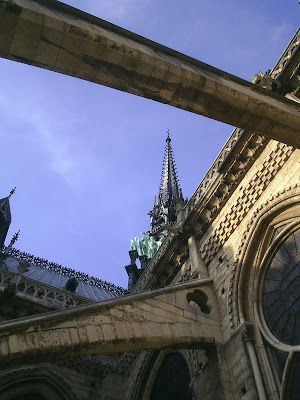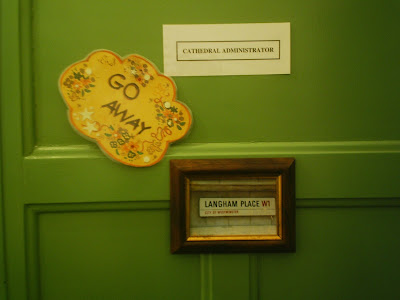
Thursday 22 February 2007
Wednesday 21 February 2007
Remember, Thou art dust ...

People these days take a great pride in their appearance. Even when, as in my case, the choice of what to wear is between black or black, I spend wasteful moments pondering which shoes to wear, which jacket. There's always that final check in the mirror before I go out.
Today, though, we wear something different - the smudge of ash on our forehead. Nothing could be more contrary to our worries about how we seem, what others think of us, how we need to appear at our best.
Today we are stripped of these things. For as the ash is placed upon our foreheads, we are brought face to face with a terrible reality. That we are not self-sufficient, we are not self-defining. The ugly smear of ash is the mark of our death. It is on our forehead. It cannot be avoided. There can be no pretence, no schemes, no compromise. We stand naked before the fact of our mortality. There is no other outcome.
Our society offers us so many beguiling words today: be young, be beautiful, be rich, be successful. Today we hear other words – dread and sobering words, which give the lie to the beguiling promises of society: "Remember thou art dust and unto dust thou shalt return". We hear the sentence of our sins, and we see the false promises for what they are. This body, this world will pass. Here is no abiding city.
Be shocked. But be filled with hope. It is not we are destined to become the dust of oblivion - but sin and death itself.
Posted by
Mark Langham
at
14:00
7
comments
![]()
Tuesday 20 February 2007
Burning the Palms
 Fr Christopher oversees the burning of last year's palm branches, in preparation for Ash Wednesday tomorrow. This is the first year we had asked people to bring in their palms from the previous Palm Sunday. We were overwhelmed with the response, and it is a more fitting way to acquire ash (in the past, we have sent away for ash that duly arrives in plastic packets from a Church supplier!).
Fr Christopher oversees the burning of last year's palm branches, in preparation for Ash Wednesday tomorrow. This is the first year we had asked people to bring in their palms from the previous Palm Sunday. We were overwhelmed with the response, and it is a more fitting way to acquire ash (in the past, we have sent away for ash that duly arrives in plastic packets from a Church supplier!).
Fr Christopher wisely opted to use the barbeque grill on the roof terrace - there will certainly be no shortage of ash this Ash Wednesday!
Posted by
Mark Langham
at
21:14
0
comments
![]()
Jumelage avec Notre Dame


The galleries used to be used as a refuge for pilgrims on the route to Santiago de Compostela.



 The interior of the bell towers was fascinating; a double arcade strengthens the walls, while a wooden structure supports the great bell (le bourdon) - not touching the stone walls, to allow for vibration as the bell is tolled. The wooden beams you see below are medieval.
The interior of the bell towers was fascinating; a double arcade strengthens the walls, while a wooden structure supports the great bell (le bourdon) - not touching the stone walls, to allow for vibration as the bell is tolled. The wooden beams you see below are medieval.

 We were fortunate to be taken into the heart of the great building, to view areas usually unseen by the public.
We were fortunate to be taken into the heart of the great building, to view areas usually unseen by the public. Above all, it was fascinating to meet the chaplains of Notre Dame and to compare notes. In France, the state owns the building, and pays for its upkeep, but grants use of it to the Roman Catholic Church. Even the musicans are paid by the State. It is hard to imagine such a situation, continually weighed down as we are in England by the need to find our own funds for the Cathedral building and music. Yet, our self-sufficiency also grants us freedom; there is a certain amount of the 'dead hand of the State', that prevents the archiprêtre of the Cathedral from developing its resounrces as he would wish.
Above all, it was fascinating to meet the chaplains of Notre Dame and to compare notes. In France, the state owns the building, and pays for its upkeep, but grants use of it to the Roman Catholic Church. Even the musicans are paid by the State. It is hard to imagine such a situation, continually weighed down as we are in England by the need to find our own funds for the Cathedral building and music. Yet, our self-sufficiency also grants us freedom; there is a certain amount of the 'dead hand of the State', that prevents the archiprêtre of the Cathedral from developing its resounrces as he would wish.  As an afterthought, I much prefer the title archiprêtre to my own of 'Administrator'. Having resisted the moves to change the title to Dean, as being inappropriate, I could certainly be content to be an archpriest. Such is the title of the rectors of European Cathedrals, and there is even a history of the use of the title in the English post-reformation Church. However, I am uncertain how the title falls on English ears, and so will remain an Administrator, a title borne proudly by my predecessors for over 100 years.
As an afterthought, I much prefer the title archiprêtre to my own of 'Administrator'. Having resisted the moves to change the title to Dean, as being inappropriate, I could certainly be content to be an archpriest. Such is the title of the rectors of European Cathedrals, and there is even a history of the use of the title in the English post-reformation Church. However, I am uncertain how the title falls on English ears, and so will remain an Administrator, a title borne proudly by my predecessors for over 100 years.
Posted by
Mark Langham
at
00:27
10
comments
![]()
Monday 19 February 2007
The Rite of Election
The Cardinal and his auxiliary bishops today formally welcomed those in Westminster Diocese who are preparing for baptism or reception into the Church at Easter. At this Rite of Election, these candidates are 'elected' or chosen by the Cardinal, and begin their final Lenten preparation for the Easter ceremonies.
 I am pround that the congregation yesterday included twenty candidates from the Cathedral parish. Like other candidates, they were present in the Cathedral with their sponsors.
I am pround that the congregation yesterday included twenty candidates from the Cathedral parish. Like other candidates, they were present in the Cathedral with their sponsors. A choir of diocesan volunteers provided the music (above). Below the Cardinal sits with the bishops, who are (from the far side) Bishop George Stack, Bishop Alan Hopes, and then Bishop Bernard Longley and Bishop John Arnold. On the north side of the sanctuary sit the Deans - the priests who have care of a particular group of parishes, and who call out the names of those parishes represented. The eagle-eyed among you will also spot the Cardinal's biretta, top right, occuping a stall next to the Cardinal's secretary.
A choir of diocesan volunteers provided the music (above). Below the Cardinal sits with the bishops, who are (from the far side) Bishop George Stack, Bishop Alan Hopes, and then Bishop Bernard Longley and Bishop John Arnold. On the north side of the sanctuary sit the Deans - the priests who have care of a particular group of parishes, and who call out the names of those parishes represented. The eagle-eyed among you will also spot the Cardinal's biretta, top right, occuping a stall next to the Cardinal's secretary.
Posted by
Mark Langham
at
04:41
4
comments
![]()
Sunday 18 February 2007
Our Lady of Lourdes Mass

Posted by
Mark Langham
at
05:01
3
comments
![]()
Saturday 17 February 2007
Dusting the Diapason - the Grand Organ Laid Bare







Posted by
Mark Langham
at
06:17
3
comments
![]()
Friday 16 February 2007
Cardinal Nicholas Wiseman
Most biographies record today as the anniversary of the death of Cardinal Wiseman, first Archbishop of Westminster. However, according to the inscription by his tomb in the Cathedral crypt, yesterday was the day.
Cardinal Wiseman lies directly beneath the High Altar, in the small chapel of St Edmund. His tomb is the only gothic monument in this otherwise Byzantine Cathedral, and was designed by Edward Pugin, son of the more famous Augustus Welby Pugin.
Panels around the monument depict scenes from the Cardinal's life; firstly, his consecration as Archbishop by Pope Pius IX in 1840 (below).
Posted by
Mark Langham
at
10:08
6
comments
![]()
Thursday 15 February 2007
I Know How He Feels

Posted by
Mark Langham
at
01:12
8
comments
![]()
Wednesday 14 February 2007
St Cyril and St Methodius



Posted by
Mark Langham
at
09:17
2
comments
![]()















